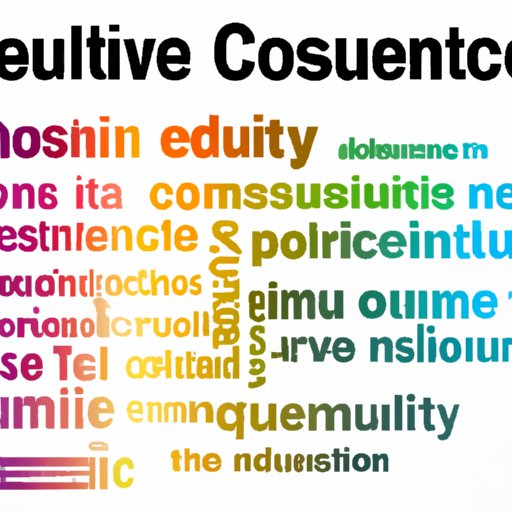Introduction
Culture is a complex concept that can be defined as “the sum total of ways of living built up by a group of human beings and transmitted from one generation to another” (Lowie, 1920). It can be seen as an expression of our collective identities, a way of connecting with others, and a source of meaning and purpose in life. This article will explore the different elements of culture and how they shape our lives and societies.
Explaining the Different Elements of Culture
Culture encompasses many different components, including physical environment, social norms, belief systems, symbols & language, and more. Let’s take a closer look at each of these elements.
Physical Environment
The physical environment plays an important role in shaping culture. According to geographer Carl Sauer, “a people’s culture is determined by its environment” (Sauer, 1925). The environment includes the land, climate, plants, animals, and other natural resources. For example, if a group of people live in a hot, dry desert, their culture will likely be shaped by the need to conserve water and find shade during the day.
Social Norms
Social norms are the accepted behaviors, practices, and values within a society. They dictate what is considered acceptable or unacceptable behavior. For example, in some cultures, it is expected that people will greet each other with a hug or handshake when meeting for the first time. In other cultures, this may not be the norm.
Belief Systems
Belief systems refer to the shared set of beliefs and values within a culture. These beliefs can be religious, spiritual, political, or moral in nature. They often form the basis of a culture’s laws and customs. For example, in some cultures, it may be believed that violence is never an acceptable solution to a problem, while in others, violence may be seen as a necessary part of resolving conflicts.
Symbols & Language
Symbols and language are two of the most powerful tools used to express and communicate culture. Symbols are objects, images, or gestures that carry meanings and associations that are understood by members of a particular culture. For example, in the United States, the bald eagle is a symbol of freedom and patriotism. Language is also an important element of culture. It is used to share knowledge, stories, and experiences, and to create connections between people.
Examining the Impact of Culture on Society
Culture has a powerful influence on our values, attitudes, and behaviors. It shapes our understanding of the world and our place in it. Here’s a closer look at how culture affects society.
Influence on Values and Attitudes
Cultural values and attitudes have a strong influence on how individuals and groups behave. Research has found that cultural values and attitudes affect decision-making, risk-taking, and problem-solving (Gardner, 2006). For example, in some cultures, it may be considered acceptable to take risks, while in others, taking risks may be frowned upon.
Impact on Behavior
Culture also has a significant impact on behavior. People tend to act in ways that are consistent with the accepted norms and values of their culture. For example, in some cultures, it is considered rude to talk loudly in public, while in other cultures, talking loudly may be seen as a sign of enthusiasm or excitement.
Effect on Political and Economic Development
Cultural values and attitudes can also affect a society’s political and economic development. For example, in some cultures, it may be considered acceptable to challenge authority, while in others, challenging authority may be seen as disrespectful. Cultural values and attitudes can also affect economic development, as those who hold certain beliefs may be more or less likely to engage in certain activities, such as entrepreneurship or investing.

Identifying the Most Influential Elements of Culture
Some elements of culture have a particularly strong influence on how we think and act. Here are three of the most influential elements of culture.
Religion
Religion is a powerful force in many cultures. It provides a framework for understanding the world and can shape values, attitudes, and behaviors. For example, in some religious traditions, it is believed that marriage should only take place between a man and a woman, while in others, marriage may be allowed between members of the same sex.
Family Structure
Family structure is another influential element of culture. Family structures vary widely across cultures, but they all provide a sense of belonging and security. In some cultures, the family is the primary source of support, while in others, extended family networks may play a larger role. Family structure also influences how parents raise their children and how children view themselves in relation to their peers.
Arts & Music
Arts and music are two of the most powerful expressions of culture. They can be used to tell stories, express emotions, and share values. Arts and music can also be used to challenge existing power structures and inspire social change. For example, in the 1960s, folk music was used to protest the Vietnam War and advocate for civil rights.
Analyzing the Role of Culture in Human Development
Culture plays an important role in human development. It can shape how we think, feel, and act. Here’s a closer look at how culture influences our development.
Role in Forming Identity
Culture plays a key role in forming our identities. Our identities are shaped by the values, beliefs, and behaviors of the culture we belong to. For example, in some cultures, gender roles are strictly defined, while in others, there is more flexibility. Our identities are also shaped by our interactions with others, which can be influenced by cultural norms and expectations.
Impact on Social Interaction
Culture has a significant impact on our social interactions. Cultural norms and expectations can dictate how we speak, dress, and behave around others. For example, in some cultures, it is common to address strangers formally, while in others, it is more acceptable to use informal language. Cultural norms can also influence how we interact with members of the opposite sex.
Effects on Cognitive Development
Culture can also affect our cognitive development. Studies have found that cultural values and beliefs can shape how we think, remember, and problem-solve (Nisbett & Cohen, 1996). For example, in some cultures, it may be considered important to think before speaking, while in others, speaking without thinking may be seen as more acceptable.

Understanding How People Perceive Cultural Elements
Culture is not static; it is constantly evolving and changing. People’s perceptions of cultural elements can also vary. Here’s a look at how people perceive cultural elements.
Perception of Diversity
People’s perceptions of diversity can vary widely. Some may see diversity as something to be celebrated, while others may see it as a threat to their way of life. People’s perceptions are often shaped by their own cultural values and beliefs.
Influence of Media
Media can also have a powerful influence on how people perceive culture. Through television, movies, and other forms of media, people are exposed to different cultures and lifestyles. This can lead to increased acceptance and understanding of cultural differences.
Intercultural Communication
Intercultural communication is the process of exchanging information and ideas between people from different cultures. It can help to bridge cultural divides and foster mutual understanding and respect. However, it is important to remember that not everyone shares the same values and beliefs, and it is important to approach intercultural communication with an open mind.

Investigating the Relationship between Culture and Language
Culture and language are closely intertwined. Language is used to express culture and transmit cultural knowledge from one generation to the next. Here’s a closer look at the relationship between culture and language.
Link between Language and Thought
Language and thought are closely linked. Our language shapes how we think about the world and how we interpret our experiences. Studies have found that bilinguals often think differently in their two languages (Bialystok, 2009). This suggests that language can influence our thoughts and perceptions.
Role of Language in Expressing Culture
Language is also an important tool for expressing culture. It can be used to share stories, experiences, and values. Language can also be used to challenge existing power structures, such as through satire or protest songs.
Cross-cultural Communication
The ability to communicate across cultures is becoming increasingly important in an interconnected world. Cross-cultural communication can help to bridge cultural divides and foster understanding and respect. However, it is important to remember that language is not the only way to communicate, and it is important to be aware of cultural differences when communicating with people from different cultures.
Conclusion
Culture is a complex concept that encompasses many different elements, including physical environment, social norms, belief systems, symbols & language, and more. These elements play an important role in shaping our values, attitudes, and behaviors, and they can have a powerful influence on our development and relationships. It is important to understand how culture influences our lives and how we perceive cultural elements in order to foster understanding and respect of cultural differences.
(Note: Is this article not meeting your expectations? Do you have knowledge or insights to share? Unlock new opportunities and expand your reach by joining our authors team. Click Registration to join us and share your expertise with our readers.)
